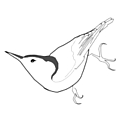Douglas Adams is known and loved for the satirical and insane stories that make up the Hitchhiker’s Guide to the Galaxy. I loved reading that “trilogy in four parts” during my high school and college years, but didn’t wonder until much later about what other books Adams had written in his short life, or indeed what his interests were.
Around the year 2005, a dear friend talked to me about one such “other book”, a strange travelogue called Last Chance to See. That seed took a long time to germinate, and it would be a decade before I got around to reading this book. It is a series of essays about trips that Adams made to exotic places in the world, along with the zoologist Mark Carwardine. Their goal was to seek out and document some of the most endangered animal and bird species in the world.
Hilarious and sad at the same time, the essays make you smile in surprise at the strange ways of nearly extinct animals. They make you wince at how thoroughly human beings have wrecked the planet and made it very difficult for other creatures. Do you recall the ironic episode in The Restaurant at the End of the Universe, in which a cow serenades the restaurant patrons and offers its body parts as delectable menu items? It was something like that, but the difference was that these were real situations about real animals on the brink of extinction.
One essay in the book describes the trip that Carwardine and Adams undertook to see aye-aye lemurs in Nosy Mangabe, an island off the coast of the much bigger island of Madagascar. For millions of years, plate tectonics protected Madagascar’s smaller lemurs by isolating them from larger African primates. But these primates, eventually, (as men) succeeded in invading Madagascar and destroying the habitat of the lemurs. The recursion and its irony is not lost on Adams:
Madagascar had been a monkey-free refuge for the lemurs off the coast of mainland Africa, and now, Nosy Mangabe had to be a monkey-free refuge off the coast of mainland Madagascar. The refuges were getting smaller and smaller and the monkeys were already here on this one, sitting, making notes about it.
My favorite chapter in the book is about their journey to New Zealand to see the habitat of a flightless parrot called the kakapo. Adams describes in hilarious detail the mating ritual of this strange bird. The male digs a shallow depression in the ground at an acoustically appropriate spot, close to a valley, for example. Then he sits in his bowl and booms, his low throbbing sounds like “an immense heart beating in the night”, a soulful telegraph to potentially interested females. This presents a small problem. The booming appears to have been evolutionarily selected for carrying over vast distances, much like the sound of a sub-woofer, but like the sub-woofer, it is very difficult to pinpoint where the booming is coming from. Females — who are flightless, remember — are known to walk as many as twenty miles before they find a booming male ready to copulate. It is actually much more complicated than that, as Adams writes:
The males […] get extremely overwrought sitting in their bowls making noises for months on end, waiting for their mates, who are waiting for a particular type of tree to fruit. When one of the rangers who was working in an area where kakapos were booming happened to leave his hat on the ground, he came back later to find a kakapo attempting to ravish it. On another occasion, the discovery of some ruffled possum fur in the mating area suggested that a kakapo had made another alarming mistake, an experience which is unlikely to have been satisfying to either party.
The net result of all these months of excavating and booming and walking and scrarking and being fussy about fruit is that once every three or four years, the female kakapo lays one single egg, which promptly gets eaten by a stoat.
I view the book as a time capsule of sorts. While the essays are often ridiculously funny, there is also a depth of feeling that comes from the knowledge that the long-lived species being described have but a few years left on earth. Adams and Carwardine made most of their trips around 1988. Almost three decades hence, nearly all the species that they documented on that trip remain critically endangered. Many are being bred in captivity, or in closely monitored habitats to avoid total extinction. The kakapo is still around, but only just. The baiji — or the Yangtze river dolphin — has been extinct since 2007.

